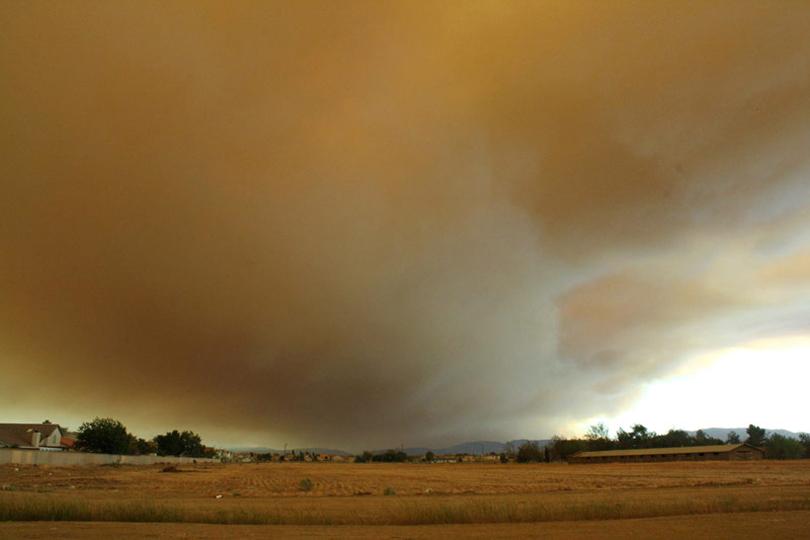
LOS ANGELES (AP) — (UPDATED) Firefighters reported some progress Tuesday against a gigantic blaze on the edge of Los Angeles, but warned that this one might be just a preview of even greater dangers ahead. The peak Southern California fire season hasn’t even started yet.
The worst fires typically flare up in the fall, when ferocious Santa Ana winds can drive fires out of wilderness areas and into suburbs. As a result, Southern California could be in for a long wildfire season.
“When you see a fire burning like this, with no Santa Ana winds, we know that with the winds, it would be so much worse, so much more intense,” said Los Angeles County fire Capt. Mark Whaling.
The Santa Anas are so devastating when they carry fire because they sweep down from the north and reach withering speeds as they squeeze through wilderness canyons and passes and plunge into developed areas.
Even though winds have been mostly calm since the blaze began along the northern fringe of Los Angeles and its suburbs, the flames have spread over 190 square miles of forest in a week. Some 12,000 homes remained threatened as 3,600 firefighters and aircraft battled the blaze across a 50-mile line.
But it was not the only significant blaze in Southern California.
In the inland region east of Los Angeles, 2,000 homes were being threatened by a fire of more than 1.5 square miles in the San Bernardino County community of Oak Glen, and a nearby 1.3-square-mile blaze was putting 900 homes at risk in Yucaipa.
“There’s action everywhere,” Gov. Arnold Schwarzenegger said as a helicopter interrupted his comments at a news conference in San Bernardino County.
The big fire, known as the Station Fire, was just 5 percent surrounded, but U.S. Forest Service incident commander Mike Dietrich said that figure could double by the end of the day, and he was pleased with progress.
“There’s a lot more work to be done,” Dietrich said. “It’s still a very treacherous situation. It could still turn around.”
Weather was more humid, which helps brush resist burning, but the downside was a possibility of dry lightning. Some sprinkles were reported, but no significant rain.
Officials were worried about the threat to a historic observatory on Mount Wilson northeast of Los Angeles. But on Tuesday, the flames near the facility appeared much tamer than the infernos that boiled up out of the mountain range in previous days.
Authorities could not immediately ascertain whether the fire at the top of Mount Wilson was the result of the overall advance of the blaze or backfires set by fire crews.
From a helicopter above the 5,700-foot peak, small flames could be seen creeping under trees. Firefighters had doused the peak with flame retardant before withdrawing when the fire appeared to be too dangerous.
Mount Wilson is home not only to the observatory but numerous television, radio and cell phone antennas serving the metropolitan area.
“The fire is still eventually going to impact around the site,” Dietrich said. “The amount of damage is yet to be seen.”
The fire is one of hundreds of wildfires in a season that usually does not gather steam until October, when the Santa Ana winds arrive.
This year’s destructive Southern California wildfires began in May, when 80 homes were destroyed and more than a dozen others were damaged in the Santa Barbara area. “Sundowner” winds, a localized version of a Santa Ana, whipped a brush fire into an inferno in neighborhoods on the edge of the Los Padres National Forest.
Wind has not been a problem in the current fire, but drought has. The region is in the midst of a three-year drought, and the tinder-dry forest is ripe for an explosive fire.
Residents had a range of emotions as they watched the fire — and they knew the lack of wind was a godsend.
“I’m a little concerned but not overly worried,” said retiree Paul Westmoreland, 77, who lives in the Seven Hills neighborhood in Tujunga. “But if we had had high winds, this whole area would have gone.”
Some of the spectators were residents who followed orders to leave but could not resist coming back to their neighborhoods.
Jennifer Pelon, 43, came back Tuesday morning to see if her 3,000-square-foot home on a hillside was still standing. She nervously watched as flames licked a ridgeline only yards from her home.
“It’s a lot of stress and anxiety, watching,” she said. “It’s your whole life up there.”
At the huge fire command center, Glendale firefighter-paramedic Jack Hayes, 31, recounted how he manned a 2,000-gallon water truck to extinguish flames bearing down on backyards.
“We’ve been knocking them all down and saving some homes,” he said.
Hayes said he had not taken a day off for a week.
“You can’t sleep,” said Hayes, who had the beginnings of a beard and bloodshot eyes. “You’re ready to go and there’s always something you could be doing.”
Two firefighters — Capt. Tedmund Hall, 47, of San Bernardino and firefighter Specialist Arnaldo “Arnie” Quinones, 35, of Palmdale — were killed Sunday when their vehicle plummeted off a mountain road. Quinones’ wife is expecting a child soon, and Hall had a wife and two adult children.
In Washington, White House spokesman Robert Gibbs said President Barack Obama and first lady Michelle Obama sent their condolences to the firefighters’ families. Gibbs said the White House will do whatever it can to assist state and local governments.
The Station Fire was the biggest but not the most destructive of the wildfires currently burning in California. Northeast of Sacramento, a fire burning over a half square mile destroyed 60 structures over the weekend, many of them homes in the town of Auburn. The fire was 80 percent contained Tuesday and no longer threatened any homes.




